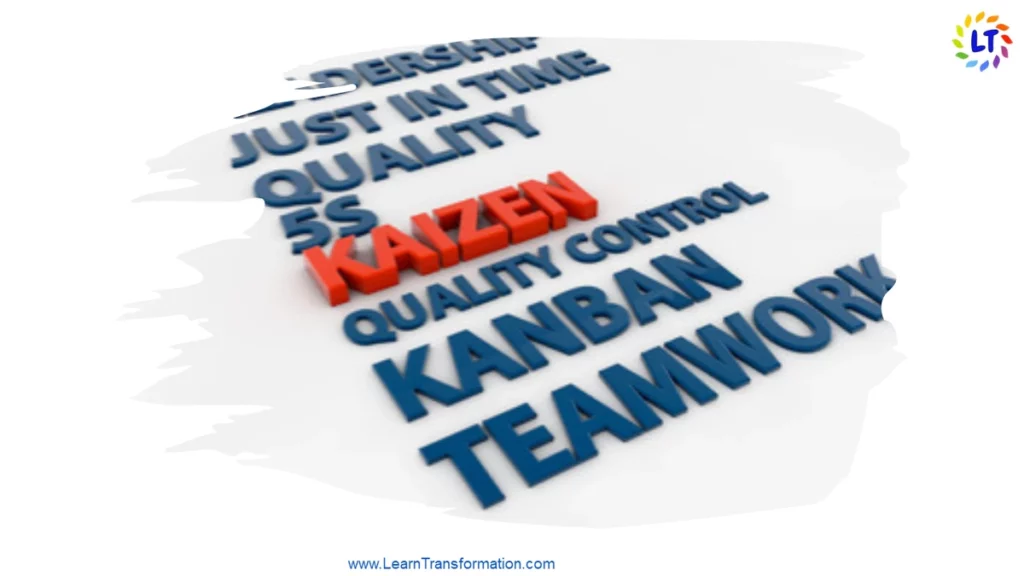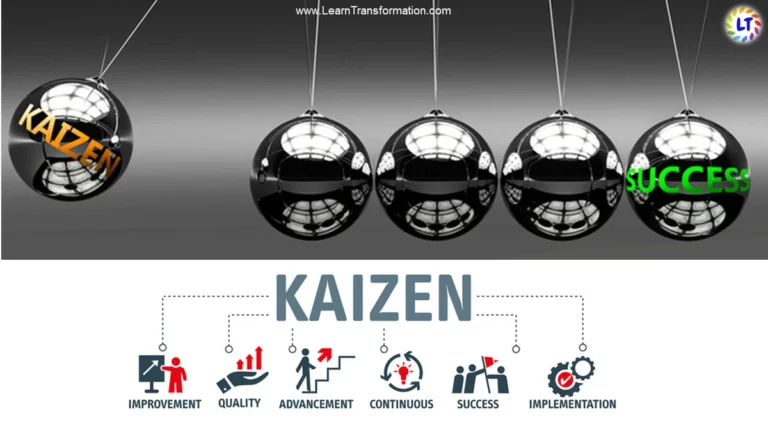If you’re not getting better, you’re getting worse.
Joe Paterno.
In 1986 Mr. Masaaki Imai released a book with title: Kaizen, the key to Japan’s Competitive Success. Kaizen (改善) comes from two Japanese words: Kai (Change)and Zen (good). Furthermore, It refers to “continuous improvement”. Moreover, Kaizen in manufacturing is defined as a continuous effort by each & every employee to make sure improvement of all systems & processes of a specific organization and is a systematic approach to raising quality, lessening delivery time & increase consumer satisfaction.
Unlock a world of knowledge with just one click: Navigating Lean Digital Transformation
Kaizen meaning as seen by the Japanese (especially Toyota as part of the Toyota Production System TPS) is a manner of engaging the workforce to come up with ideas for improvement, each employee is expected to come up with (and implement) 3 to 5 improvement ideas. The strength of Kaizen is not always within the individual small improvement but in the united power of many hundreds of small improvements moving the business forward consistently.
Implementing Kaizen tools is not the responsibility of a single individual but includes every member who is directly linked with the organization. So, Every individual, irrespective of his/her position in the hierarchy requires to contribute by incorporating small improvements and changes in the system.
The objective of the Kaizen process is to make the organization, and its services, products, and people, better by executing small-scale changes all over the company. So, The element of Kaizen aims to remove waste in an enterprise by enhancing standardized activities and processes. Kaizen is a culture & not so much a plan of action or a model. There are some ways to promote Kaizen culture, such as Gemba Kaizen.
What is Gemba Kaizen?
Gemba Kaizen refers to “the continuous improvement of the workplace”. Consequently, The employees manage the products and services for the consumers. Hence, Gemba Kaizen implements improvements on the shop floor & detects practical problems. Furthermore, The executives solve these operational problems themselves by spending the whole day on the shop floor and have the most knowledge of it.
How to Implement in Manufacturing & Non-Manufacturing?
With time, small incremental improvements can deliver notable outcomes. It’s process steps also promote conditions in which employees are deeply involved. When implemented successfully & clearly, Kaizen attains to important needs of employees:
- Connection: Feeling associated with a higher organizational objective, to their work, and their colleagues for a successful human transformation.
- Control: A sense of ownership as well as awareness throughout the transformation process.
- Creation: Opportunities to think and solve existing problems with creative, yet practical solutions.
Kaizen activities wrap improvements in some areas, including:
- Quality: Better products, work environment, business service, practice as well as processes for quality transformation.
- Delivery: Shortening delivery time, movement as well as non-value-added activities.
- Cost: Reducing expenses and manpower, and use of material, energy, and resources.
- Management: Improving procedures, documentation, training, morale, planning, information systems, flow, and reporting.
- Safety: Decreasing hazardous situations, chances of resource exhaustion, risky working conditions & damage to the environment in VUCA.
Also, See- What are the Lean Concepts and Lean Principles?
Leader’s Tip
Encourage staff participation, offer training materials, and reward tiny incremental changes to promote a culture of continuous improvement.
What is The Kaizen Process?
Kaizen process has 6 phases:
- Find a problem or opportunity.
- Evaluate the process.
- Produce an optimal solution.
- Implementing solution.
- Examine the results & adjust.
- Standardizing solution.
Additionally, The Kaizen process begins with a problem, more accurately the recognition that a problem exists and that there are opportunities for improvement. Once problems are identified, the organization requires to join the cross-functional personnel to understand the underlying cause of it. Solutions are then tested. So, The team makes adjustments to the solution by utilizing data. Consequently, the results are spread across the organization and the solution is standardized.
What are 7 Benefits of Kaizen Process?
So, Kaizen 5s aims for improvements in productivity, quality, effectiveness, communication, safety, and waste reduction.
- Less Waste – Inventory is used more efficiently as are employee skills.
- Improved Consumer Satisfaction – The customers feel highly satisfied with the implementation of Kaizen process.
- Improved Communication – Working together to solve problems helps build as well as strengthen existing teams.
- Enhanced Commitment – Team members have more of a stake in their task and are greater willingness to commit to doing a terrific job.
- Improved Competitiveness – Increases in efficiency tend to contribute to decreasing costs & higher quality products for implementing lean transformation.
- Improved Retention – Satisfied as well as engaged people are more likely to stay.
- Improved Problem Solving – Looking at processes from a solutions perspective allows employees to solve problems consistently.
What are key Kaizen Principles?
The complete purpose of It’ principles is to seek where processes break down & where problems arise from, finding the root cause to fix the problem where it begins. So, Even leaders need to be ready to find their mistakes. Mistakes are seen as opportunities to grow & learn.
There are Five Main Principles in Kaizen
1. Know Your Customer:
Knowing who you are selling a product or service to is how one creates value. So, The key is to figure out what your customer wants & how you can improve their experience based on what they value.
2. Let It Flow:
Zero waste should be a company-wide aim. It might be an impossible goal, but that’s kaizen for you. So, each and everyone in the organization focuses on reducing & removing waste, while also in the business transformation process of creating value.
3. Go To Gemba:
The translation of Gemba is “the actual place.”Certainly, It’s about leadership as well as knowing what is happening at every level of the organization. So, Follow the action and locate where the value creation & go there to use Kaizen principles.
4. Empower People:
This one is directed towards teams as well as having them organized in such a manner that it supports the kaizen principles. Organize teams with clear directives and goals but be sure to equip them with the right tools and systems they need to be successful.
5. Be Transparent:
Data is the strongest ruling factor. Moreover, It’s the measure that determines success. Use data to show how improvements are changing the organization so they are “real and visible.”
Also read: 5 Key Business Transformation Strategies
How to Implement Kaizen?
So, To generate a Kaizen process, everyone engaged must begin thinking about their work in a new way – in terms of-
- Now: Present condition.
- Next: Desired state.
- New: How to reach that state.
Generally, the Implementation of the It’s process occurs in 3 stages in any organization:
1. Motivate Participation:
Awareness training sessions for all employees are a must. To further inspire employee engagement, foster particular Kaizen activities, and consider distributing economic or real benefits after solutions from Kaizen activities are implemented.
2. Training & Education:
Concentrated training of associates is needed for understanding what is – and is not – the quintessence of Kaizen process. So, Team leaders have to learn to recognize Kaizen in an organizational vision context, which requires to be followed thoroughly to attain desired business goals.
3. Quality Level Enhancement:
After the training stage is completed, practitioners ought to continue to focus on long-term period implication, massive application, alignment with organizational desires as well as making plan objectives. Moreover, Management should form a core department to carry out Kaizen evaluation & implementation.
Leader’s Tip
Promote a mindset of Kaizen by encouraging employees to identify and address problems proactively, and empower them to suggest and implement improvement ideas.
What are Best Practices Of Kaizen?

- Keep ideas record that you’d like to improve. Hence, It’s often easier to spot them in the heat of the moment. Replace normally fixed ideas with fresh ones.
- Question current practices & standards. So, If you want to rise and improve your business, you must reflect on what you do now.
- Identify regions wherein there is “Muda or waste”. Thus, Use your ideas record as input. How waste can be removed?
- Seek the advice of associates before beginning a Kaizen activity. Create an environment where employees aren’t afraid to speak up when they find a weak point.
- Plan out when you’re going to make these changes.
- Do not seek perfection. Kaizen doesn’t exist to suddenly perfect systems or processes, but to simply improve them. Implement a solution proper away, although it covers the handiest 50 % of the target.
- Use Kaizen 5S and other strategies. So, If the adjustments have an impact on others, make sure to seek advice from them about the new arrangements, and pay attention to their comments.
- Potential solutions should be strategically implemented and monitored through a Plan, Do, Check, and Act (PDCA) cycle. So, The PDCA is a continuous cycle and framework that can help improve any process or product by breaking it into smaller steps.
- Plan (P) – Find a problem or opportunity & set out a plan for consistent change. Further, Create a hypothesis for what possible issues may be.
- Do(D)– This is the testing phase in lean transformation. Additionally, This will be a small-scale test where you can easily measure results & obtain a higher understanding of your hypothesis.
- Check(C)– Evaluate if the problem is fixed.
- Act(A) – If the preliminary test was successful, repeat it on a larger scale.
5W and 1H of Kaizen– The objective is manufacturing without any waste by enhancing standardized activities as well as processes.
Final Thought
At last, Kaizen and Kaizen principles are a splendid manner to formalize a few easy improvement activities that are not constantly run in an optimal format. So, Kaizen can enable notable & sustainable improvements to any organization.
4 Best Lean Principles Books
Global Reader’s Click Below:
- A Factory of One: Applying Lean Principles to Banish Waste and Improve Your Personal Performance
- The 12 Principles of Manufacturing Excellence: A Lean Leader’s Guide to Achieving and Sustaining Excellence, Second Edition
- The Lean Six Sigma Pocket Toolbook: A Quick Reference Guide to 100 Tools for Improving Quality and Speed
- The Lean Turnaround: How Business Leaders Use Lean Principles to Create Value and Transform Their Company
India Reader’s Click below:
- Lean IT – Principles to Practice: Toyota Way to Create Value for the Customer & Wealth for IT Organization
- Creating a Lean R&D System: Lean Principles and Approaches for Pharmaceutical and Research-Based Organizations
- Lean Principles and Application in BPO
- The Principles of Product Development Flow: Second Generation Lean Product Development
Check out the Video
Frequently Asked Questions
What are the benefits of implementing Kaizen?
Kaizen 5s aims for improvements in productivity, quality, effectiveness, communication, safety, and waste reduction. Benefits of kaizen are:
- Less Waste
- Improved Consumer Satisfaction
- Improved Communication
- Enhanced Commitment
- Improved Comp etitiveness
- Improved Retention
- Improved Problem Solving
How Kaizen is implemented in manufacturing?
The Kaizen process has 6 phases:
- Find a problem or opportunity.
- Evaluate the process.
- Produce an optimal solution.
- Implementing solution.
- Examine the results & adjust.
- Standardizing solution.
Key Takeaways
- Focus on little, gradual modifications that add up over time to produce noticeable benefits.
- Engage and empower staff members at all levels to participate in the process of ongoing improvement.
- Systematic Approach: Take a methodical approach to conducting root cause analyses and putting into practise long-term fixes.

